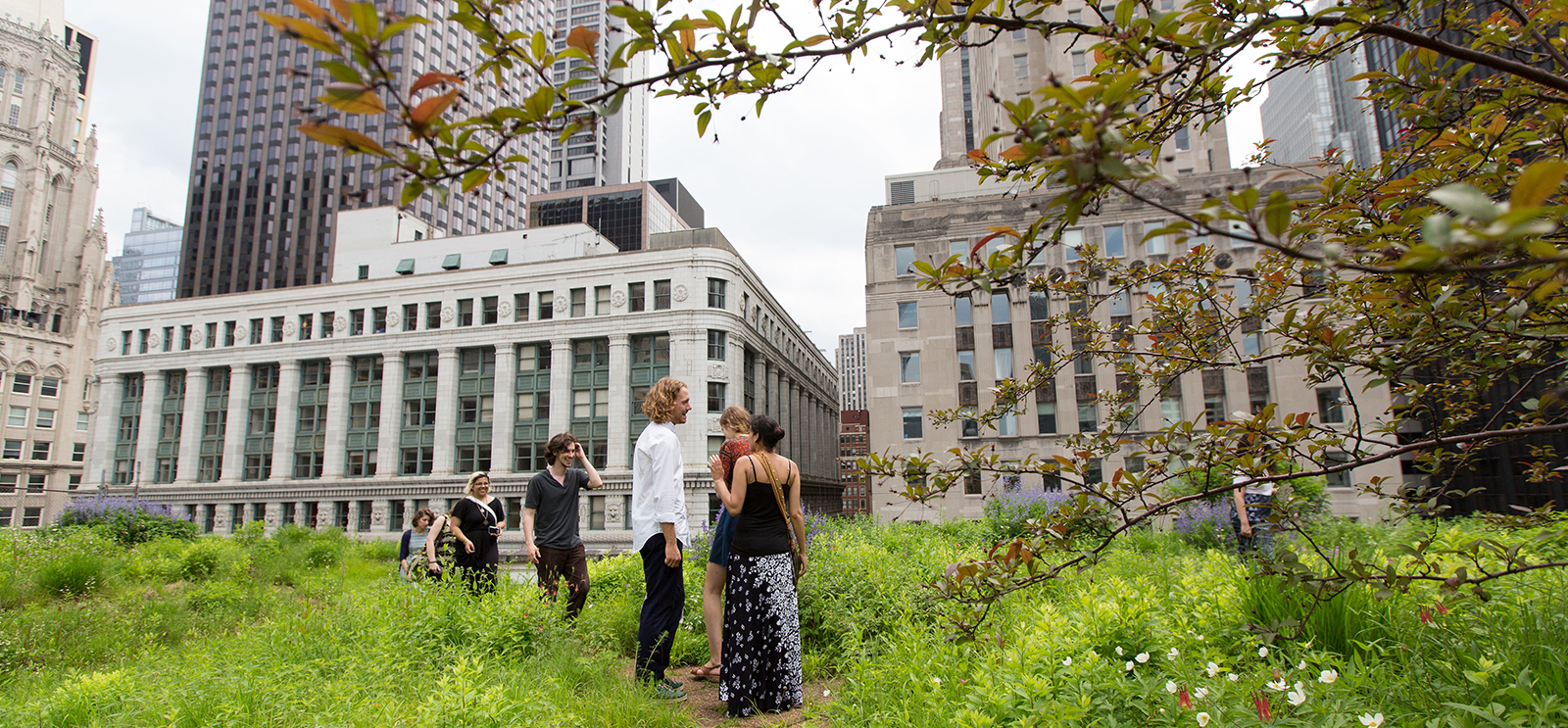
(Photography by John Zich)
A Study Chicago excursion to City Hall.
Last spring the College ran the Study Chicago quarter for the first time. Inspired by the College’s Study Abroad offerings, the Study Chicago program included courses in history, literature, and public policy, as well as group excursions on Fridays.

Before you go out onto the City Hall roof garden, you have to sign a waiver.
The parapet wall of the historic building is low and uneven. At the southwest corner it’s only a foot high. So visitors are supposed to stay toward the inside of the path. You’re not allowed to look over the edge.
Only half of the Study Chicago group—about 12 people at a time—can go onto the roof at once.
But it’s worth the hassle and the wait. In late May, the roof is a sliver of rolling prairie, high above the brick and asphalt of the city.
[[{"type":"media","view_mode":"media_original","fid":"3414","attributes":{"alt":"","class":"media-image","height":"468","typeof":"foaf:Image","width":"500"}}]]
[[{"type":"media","view_mode":"media_original","fid":"3415","attributes":{"alt":"","class":"media-image","height":"367","typeof":"foaf:Image","width":"500"}}]](Photography by John Zich)
Chicago has more green roofs than any other city in the United States, Michael Berkshire of the city’s Department of Planning tells the students. It’s among the top three cities in the world.
(“The idea of green space in Chicago is so central to Chicago’s history and growth as a city,” Katherine Aanensen, Class of 2016, observes later. As well as a couple of birds, she also saw “another green roof from our roof.”)
Planted in 2000, the roof garden features more than 200 species of plants, mostly indigenous prairie plants. “This is the Rolls Royce end of the spectrum,” Berkshire says.
It’s irrigated by popular demand, rather than necessity. The summer after the garden was installed was very dry, Berkshire explains. When the plants went dormant—that is, brown—the neighbors complained.
Berkshire leads the group to the east border of the garden, where it ends abruptly. The building is shared between the city and the county, which “chose not to vegetate their side,” he says.
The result was a perfect natural experiment. On a 90-degree day, Berkshire says, the temperature on the city’s side was measured at 90 degrees. On the county’s side, it was 170.

The next stop is the second floor of City Hall, where the City Council meets. The students sink into brown leather arm chairs. The tables, for no obvious reason, are covered in itchy blue polyester.
[[{"type":"media","view_mode":"media_original","fid":"3416","attributes":{"alt":"","class":"media-image","height":"468","typeof":"foaf:Image","width":"500"}}]](Photography by John Zich)
During City Council sessions, the mayor sits at the front, with lawyers to each side, explains our guide, Claudia Chavez. The city clerk sits in the second row with her staff. The aldermen’s chairs are numbered one to 50. Edward M. Burke, the longest-serving alderman, gets two seats; an assistant sits next to him.
“In a city like Chicago, where everyone is on the same end of the spectrum, where do the main controversies arise?” asks Chelsea Fine, Class of 2016. A public policy major, Fine has been to City Hall many times. Last year she worked as an intern for the Office of Press and Communications.
[[{"type":"media","view_mode":"media_original","fid":"3417","attributes":{"alt":"","class":"media-image","height":"468","typeof":"foaf:Image","width":"500"}}]]
[[{"type":"media","view_mode":"media_original","fid":"3418","attributes":{"alt":"","class":"media-image","height":"413","typeof":"foaf:Image","width":"500"}}]](Photography by John Zich)
“A lot of people make that assumption, but there are lots of opinions,” Chavez says. “People fall on all sides for different reasons.” (Chavez’s other answers are similarly noncommittal; when asked “What’s it like to be a woman in government?” she responds, “I love what I do.”)
After the question-and-answer session, the group is permitted to snap photos at the mayor’s desk. Study Chicago lecturer Chad Broughton, AM’97, PhD’01, whose class Remaking Chicago focuses on public policy issues, poses gleefully in the mayor’s chair with a student on each side.

Then it’s on to the main event: a meeting with the mayor himself. The students gather in a room that’s recognizable from TV broadcasts of mayoral press conferences.
Rahm Emanuel enters from a door at the back. He shakes the hands of the students in the front row, then immediately starts asking them questions. “What’d you read for the history part [of Study Chicago]?” he wants to know. “Give me your favorite book. Did you do anything on Millennium Park?” The students respond with short answers, impatient to get to their own questions.
Standing next to the podium, hands in his pockets, Emanuel seems relaxed. “What do you guys want to talk about?” he says finally. “I’m just the mayor.”
[[{"type":"media","view_mode":"media_original","fid":"3419","attributes":{"alt":"","class":"media-image","height":"576","typeof":"foaf:Image","width":"500"}}]]
[[{"type":"media","view_mode":"media_original","fid":"3412","attributes":{"alt":"","class":"media-image","height":"343","typeof":"foaf:Image","width":"500"}}]](Photography by John Zich)
A student asks about public housing. “You all look so young,” says Emanuel, “but if you knew the history of public housing in Chicago, it was a good initiative that got off track.” Building mixed-income housing was “exactly the right plan,” he says, but when the economy crashed in 2008, the voucher system “fell down on the job.”
Another student asks about the CTA. How can the city help people in isolated communities? Public transportation, Emanuel responds, is more of a factor in getting people to work than skills training. The Red Line on the South Side, rebuilt in 2013, “needed the biggest investment,” he says. “It’s an essential piece of getting people from the South Side to work.”
The door behind Emanuel opens. An unseen person silently indicates he needs to wrap it up.
Fine gets in one last question. After the last election—when he failed to win a majority of the vote—what is he planning to do to bring the city together?
The famously fiery Emanuel bristles just a tiny bit. “I slightly disagree with you,” he says.
He throws out one statistic after another: the percentage of voters of various races who supported him in the most recent election and the one before. In his analysis, not much changed between elections.
“It’s less about groups and more about strategy,” he says. “I reject pitting one part of the city against another.”
His last, rather gentle, parting shot before he disappears through the door: “If you didn’t vote for me,” he says, “it doesn’t mean you don’t love the city of Chicago.”
